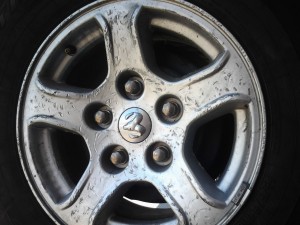Corrosion and rust are the number one enemy of the mechanic. It can destroy metal and weld parts together. Removing a stuck wheel, brake rotor or caliper bracket that has fallen victim to corrosion can be a real knuckle buster. But if you know a few secrets, then you can avoid getting stuck.
Just remember that corrosion is not normal on some brake components like brake pads and shoes. If brake pads are extremely corroded, replace them immediately because the rust can get between the backing plate friction material and cause brake failure. Some replacement brake pads are galvanized and use a mechanical attachment to prevent delaminate in corrosive environments.

Stuck Brake Rotors
When a brake rotor seizes to the flange, it is the rust and corrosion on the inside hat of the rotor and the flange that prevents removal. The secret is to focus on the hat and flange of the rotor. Don’t worry about the plates or friction surfaces. The goal is to break up the corrosion with blows of the hammer on the hat. Small movement of the rotor will add up until it breaks free.
 Lug Nuts:
Lug Nuts:
The secret to removing lug nuts with the least amount hassle is FEEL. A pro mechanic knows when he should stop with a pneumatic or cordless impact wrench. They stop because they feel the nut deforming. The pro will switch to a breaker bar and a different socket.
Most pros have special sockets and bits that can remove the lug nut. With lug nuts that have chrome caps, corrosion between the shell and nut can cause swelling. This might cause a socket not to fit or the lug nut to not come out of the socket. There are oversized sockets with an extra .5 mm in the bore for these issues. Always attack lug nuts with a six-point socket
Stuck Wheels: A wheel that has seized on a bearing or axle hub can slow down a brake job — corrosion forms around the hub and wheel. One shop solution is to loosen the lug nuts and spray a penetrating agent on the hub. Maybe try rocking the vehicle from side to side if needed. If the vehicle is on the lift, the solution might be to gently strike the backside of the wheel or tire with a sledgehammer.
Your last resort might be to drive the vehicle slowly 50 to 100 feet and rock the steering wheel from side to side with the lug nuts lose. This typically does not work well for hub-centric wheels. Be careful!
Heat is not your friend. Using the “gas wrench” or torch can lead to some not-so-good results. With almost all vehicles coming with alloy wheels, heat and some solvents in penetrating oils might damage the coatings.
 Caliper Bracket Bolts
Caliper Bracket Bolts
The caliper bracket bolts are typically M12 bolts or larger. Due to their location, corrosion can get between the threads on the knuckle and bolt. The secret to removing these bolts without damage is to use a six-point socket and not a 12-point socket. Some bolts are held in with a blue thread-locking compound call Loctite. Breaking it loose may require a little extra force. If you are stuck, apply a little heat to liquefy the Loctite.
Chemicals
A penetrating agent can’t hurt. They have come a long way in terms of their chemistry and application methods. Penetrants are different than lubricants. Penetrants can get between the surfaces that are rusted — lubricants are designed to simply lubricate.
Hammers
The hammer was one of humankind’s first tools. When using one to remove a stuck rotor or drum, the primary job of the hammer is not to pound the stuck component off the hub. A hammer should be used to break up the corrosion at the hub. Hammering the areas between the lug studs with an air hammer will often break the drum or rotor so it can be pulled by hand. Hammering on the edge of a rotor or drum will eventually knock a rotor off, but you might damage the edge of the rotor’s plate or the dust shield.
Pullers: There have been a lot of tools designed to remove stuck rotors and drums. Most are designed to put force on the rotor while pushing against the lug nuts or flange. These work and are always being refined, so they take less time to set up.
Heat: Heating with a torch must be used with great caution, does two things. First, it breaks up the corrosion by causing the components to expand and contract. Getting a rotor or drum cherry red does not guarantee that it will come off.
